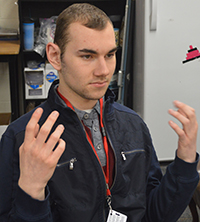Senior Nathan Ketchpaw uses sign language with big motions –– wide arms, a broad grin. His favorite sign? “Lion,” he demonstrates, running his hand through his hair, like a paw through a mane.
Excitement was on clear display in East Kentwood High School teacher Cheryl Franks’ sign-language class recently, where Nathan and his Moderate Cognitive Impaired classmates used quick hand motions to sign animal names. They played Simon Says, attempting to be the last student standing, or rather, signing.

Fish, Mom, happy, table, glasses, rain, truck, dinner and socks, they signed, demonstrating a small portion of words they have learned thanks to Franks. They can even sign full sentences and have conversations. They signed “excited” and “enthusiastic,” their expressions matching the words.
Their new abilities are more meaningful than meets the eye. The class teaches special education students an alternative form of communication. For some, it has led to major breakthroughs.
Franks spends two hours each morning teaching Signed English as an elective to special education students. (It differs from American Sign Language because it uses a sign for every English word, whereas ASL is a language that has a unique grammar and vocabulary that is different from English or any other spoken language.) Conversing with them is a joy, she said.

“Using sign language to talk is so much fun,” Franks said. “We can talk back and forth. I can ask them things. They can answer me in sign.”
In the hallway, MoCI student Daminh Nguyen says and signs, “You, you, good morning!” He was nearly non-verbal before learning to sign, Franks said. Now he talks a little and signs. “He can say all of his classmates’ names out loud.”
Making New Connections
Franks, who also teaches a special education English class, has taught at East Kentwood since 2004. Initially self-taught in signing, she attended Grand Rapids Community College to learn more. Last year, five students in MoCI teacher Brandy Ghoston’s class were nonverbal, and Franks wanted to teach them to sign.

Students loved it, she said, and picked up words like sponges. They now use it all day long in Ghoston’s class.
“The coolest part is I’ve seen students make connections with reading that they’ve never been able to,” Ghoston said, adding that they have gotten so good at signing, they teach her words and correct her.
In sign, they’ve Christmas caroled, read Dr. Seuss books to elementary students and presented “It’s a Deaf, Deaf World,” a simulated experience of being deaf, to general education students.
Some students also lack dexterity in their hands, Franks said, and signing helps loosen them up.

Building Family Bonds Too
Senior Haley Misiewicz, a general education student, received special permission to take Franks’ class. She wanted to communicate more with her sister, Jessica, who has special needs and also learned to sign from Franks.
“She would come home and sign things and I thought it was so cool,” said Haley, who plans on becoming a special education teacher. “It’s easier for her to communicate with me that way. It’s super cool. Every day I learn something here and I go home and sign new words with her.”
CONNECT
Article on Sign Language with Special Needs Students










